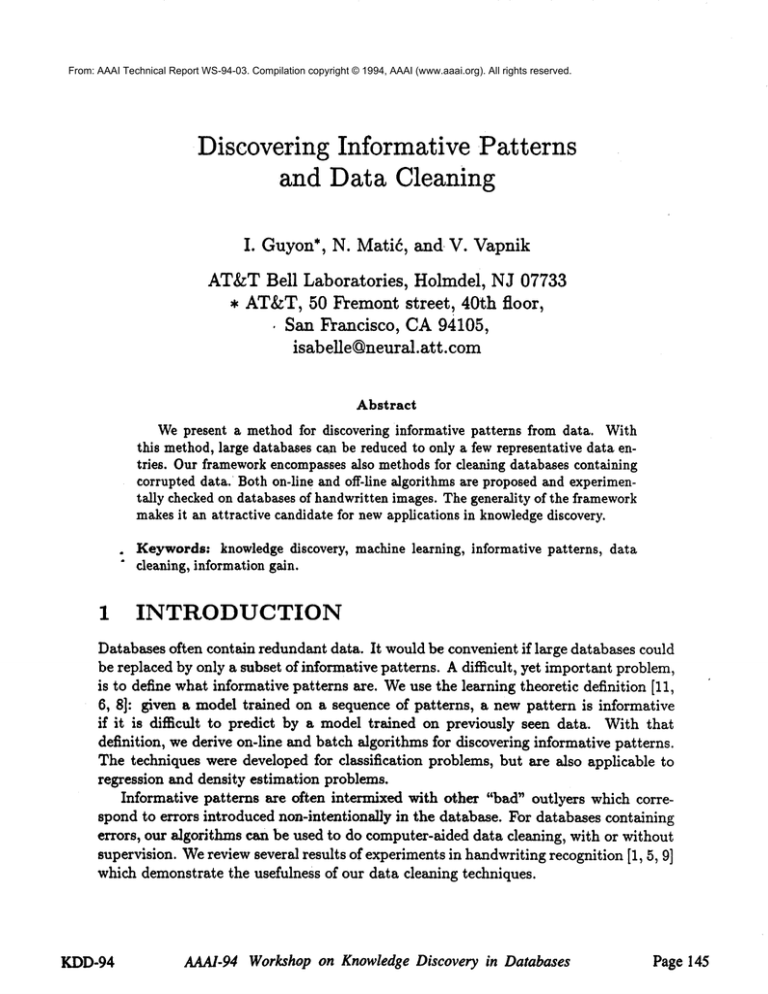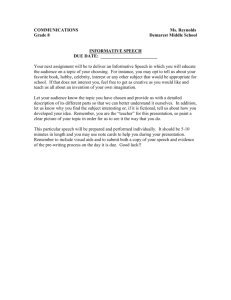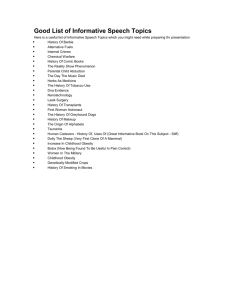
From: AAAI Technical Report WS-94-03. Compilation copyright © 1994, AAAI (www.aaai.org). All rights reserved.
Discovering Informative .Patterns
and Data Cleaning
I. Guyon*, N. Matin, and V. Vapnik
AT&TBell Laboratories,
Holmdel, NJ 07733
¯ AT&T,50 Fremont street, 40th floor,
San Francisco, CA 94105,
isabelle@neural.att.com
Abstract
Wepresent a method for discovering informative patterns from data. With
this method, large databases can be reduced to only a few representative data entries. Our frameworkencompassesalso methodsfor cleaning databases containing
corrupted data. Both on-line and off-line algorithms are proposed and experimentally checkedon databases of handwritten images. The generality of the framework
makesit an attractive candidate for newapplications in knowledgediscovery.
Keywords-knowledge discovery, machine learning, informative patterns,
cleaning, informationgain.
1
data
INTRODUCTION
Databases often contain redundant data. It would be convenient if large databases could
be replaced by only a subset of informative patterns. A difficult, yet important problem,
is to define what informative patterns are. Weuse the learning theoretic definition [11,
6, 8]: given a model trained on a sequence of patterns, a new pattern is informative
if it is difficult to predict by a model trained on previously seen data. With that
definition, we derive on-line and batch algorithms for discovering informative patterns.
The techniques were developed for classification problems, but are also applicable to
regression and density estimation problems.
Informative patterns are often intermixed with other "bad" outlyers which correspond to errors introduced non-intentionally in the database. For databases containing
errors, our algorithms can be used to do computer-aided data cleaning, with or without
supervision. Wereview several results of experiments in handwriting recognition [1, 5, 9]
which demonstrate the usefulness of our data cleaning techniques.
KDD-94
AAAI-94 Workshop on Knowledge Discovery in Databases
Page 145
"-Pattemi ..
i .:~~.
~
Pattern
number
Fraction
~ Surprise"
of
votes
for
label one w ~ level-
(b)
(a)
Figure 1: Small example database containing "zeros" and "ones". (a) A data entry.
(b) A sequence of data entries during a training session showing the variation of the
surprise level. The patterns which are most surprising are most informative.
2
DISCOVERING
INFORMATIVE
PATTERNS
In this section, we assume that the data is perfectly clean. First, we give an intuition
of what informative patterns ought to be. Then, we show that this intuition coincides
with the information theoretic definition. Finally, we derive algorithms to discover
informative patterns.
2.1 Informative Patterns are most Surprising
In figure
I, we constructed
a smallexample
database
containing
onlyhandwritten
zeros
and.ones.
Mostpatterns
of a givencategory
looksimilar.
A typical
zerois a circle
and
a typical
oneis a vertical
bar.However,
thereexistothershapes
of zerosandones.If
we wanted
to keeponlya fewdatarepresentatives,
we wouldprobably
keepat leastone
example
of eachbasicshape.
To choosethe bestdatarepresentatives,
we run an imaginary
experiment.
Imagine
thatwe found100 peoplewho didnot knowat all whattheshapeof a zeroand thatof
a one are.We teachthosepeopleto recognize
zerosand onesby letting
themexamine
the patterns
of our database
in sequence.
Everytimewe showthema new image,we
firsthidethelabelandletthemmakea guess.
We showin figure1 the average
valueof the guesses
for a particular
sequence
of
data.Sincewe assumed
thatour subjects
had neverseena zeronor a one beforethe
experiment,
about50% guessed"zero"and 50% guessed"one"whentheywere shown
the firstpattern.
But,for the secondexampleof the sameshape,the majority
made
the correctguess.As learning
goeson, familiar
shapesare guessedmoreand more
accurately
aridthe percentage
of wrongguesses
raisesonlyoccasionally
whena new
shapeappears.
We represent
withthe sizeof a question
marktheaverage
amountof surprise
that
was generated
amongour subjects
whenthe truelabelwas uncovered
to them.People
who guessedthe correctlabelwherenot surprised
whilepeoplewho madethe wrong
guess were surprised. Wesee on figure 1 that a large average surprise level coincides
Page 146
AAAI-94 Workshop on Knowledge Discovery in Databases
KDD-94
with the apparition of a new shape. Therefore, the level of surprise is a good indication
of howinformative a pattern is.
Moreformally, the level of surprise varies in the opposite direction as the probability
of guessing the correct label Pk(~k= Yk)= P(~k = yk[z~; (x0, Y0), (zl, Yl), ...(Xk-1, Yk-1))l.
This probability of making the correct guess is precisely what is involved in Shannon’s
information gain:
I(k)=--logP~(~k=yk)=--yklogPk(~k=
1)--(1--yk)log(1--Pk(~k=
1))
(1)
where Sk is an image, YkE {0, 1} is its associated label, k - 1 is the numberof data
entries seen thus far and ~k is the label predicted for pattern Xk. The log dependency
ensures additivity of information quantities. In the information theoretic sense, the data
entries that are most informative are those that are most surprising.
2.2
Machine Learning Techniques
Gain
to Estimate
the Information
It is somewhatunrealistic to hire 100 ignorant people to estimate the information gain.
Let us now replace people with machines.
In the Machine Learning framework, patterns drawn from a database are presented
to the learning machine which makes predictions. The prediction error is evaluated and
used to improve the accuracy of further predictions by adjusting the learning machine
parameters.
Assumefirst that we trained 100 different learning machines (substituting our 100
people), each one predicting its own value of ~k. This is referred to as a "Bayesian"
approach [8]. Formula 1 can be readily used to determine the information gain. Although this is a perfectly valid method, we propose here a more economical one: we
train a single learning machine to give an estimate Pk(Yk = 1) of the probability that
the correct label is "one" (figure 2). Our prediction ~k will me the most likely category
according to Pk(Yk -" 1). In formula 1, we substitute l=~k(Yk -" 1) to Pk(Yk "- 1).
ManyMachine Learning techniques can be applied to discover informative patterns.
For example, the learning machine can be a simple K-nearest-neighbor classifier [4]. All
patterns presented to the classifier are stored. Jbk(yk "- 1) is given by the fraction of the
K training patterns that are nearest to Xk which have label "one".
Another example is a neural network trained with a "cross-entropy" cost function
for which the information gain is the cost function itself. The mean square error cost
function (Yk -- Pk(Yk -- 1)) 2 provides an information criterion which ranks patterns in
the same order as the cross-entropy cost function and can therefore be used as well.
In the following, we use the size of the symbol "question mark", in the figures, and
the notation I(k), in the text, to represent the information criteria used to measure the
"surprise level".
1Tobe perfectly correct, the probabilityshouldbe also conditionedon the modelclass.
KDD-94
AAAI-94 Workshop on Knowledge Discovery in Databases
Page 147
A
P(y~,
1
I(k)
Figure 2: A learning machine used to predict the information gain (or surprise level).¯
In the classical machine learning framework, the goal is to train the learning machine,
either to provide a model of the data or to make predictions. In our frameworkthe goal
is to discover the informative patterns of the database (dashed line).
2.3
On-line
Algorithms
and Batch Algorithms
In an on-line algorithm, patterns are presented in sequence and the learning machine
adjusts its parameters at each presentation of a newpattern. This is a situation similar
to that of our example of section 2.1. In that case, we will say that a pattern is
informative if the information gain exceeds a pre-defined threshold. The disadvantage
of this method is that informative patterns depend on the sequence in which patterns are
presented. However, there may be practical situations where the data is only available
on-line.
In a batch algorithm, conversely, all data entries are available at once and the information gain is independent on pattern ordering. This implies that, if there are p data
entries in the database, we need to train p machines, each one on all the data but one
pattern, and then try to predict that last pattern. In practice, this is feasible only if
training is unexpensive, as for the K-nearest-neighbor algorithm.
For other batch algorithms, we rather train the learning machine only once on all the
data. Wethen approximate the information gain of each pattern with an estimate of
how much the cumulative information gain would decrease if we removed that pattern
from the training set.
For batch algorithms all the patterns of the database are uniquely ranked according
to their information gain. The m most informative patterns can be selected to represent
the entire database.
2.4
Minimax
Algorithms
Minimaxalgorithms are batch algorithms that are particularly well suited to discover
informativepatterns.- Mostalgorithmstrain the learning machineto minimizethe
averageloss (e.g. the mean-square-error).
Minimax
algorithmsminimizethe maximum
loss:
(2)
Page148
AAAI-94Workshopon KnowledgeDiscoveryin Databases
KDD-94
where w represents the parameters of the learning machine and k runs over all data
entries. Minimaxalgorithms are extreme cases of some "active learning" methods which
emphasize the patterns with large information gain [8]. The solution of a minimax
algorithm is a function of only a small subset of the training patterns, precisely called
"informative patterns" [12]. These are the patterns that have maximumloss.
In reference [1], we propose and study a minimaxalgorithm for classification problems: the OptimumMargin Classifier.
The algorithm maximize the minimumdistance
of the training patterns to the decision boundary. It is shownthat the solution w* is a
linear combination of basis functions of the informative patterns:
ak> 0,
(3)
k--1
where yk ~ {0,1} indicates the class membershipand the ak coefficients are all zeros,
except for the informative patterns. Weuse the value of the cost function at the solution
as cumulative information criterion:
k--1
from which we derive and estimate of the information loss incurred by removing the
informative pattern k:
I(k)
(5)
One important question is: what is the rate of growth of the number of informative
patterns with the size of the database. The results of experiments carried out on a
database of handwritten digits using the Optimal Margin Classifier suggest a logarithmic
growth, in the regime when the number of patterns is small compared to the total
numberof distinct patterns (figure 3).
Other minimaxalgorithms have been proposed for classification and regression [3, 2].
3
DATA
CLEANING
In thissection
we tackletheproblem
of realworlddatabases
whichmay contain
corrupteddataentries.
We proposedatacleaning
algorithms
and analyzeexperimental
results.
3.1 Garbage Patterns are also Surprising
The information
theoretic
definition
of infor,,,ative
pattern
doesnotalwayscoincide
withthe commonsensedefinition.
In figure4, we showexamples
of patterns
drawn
from our database of "zeros" and "ones", which have a large information gain. Wesee
two kinds of patterns:
¯ Patterns that are actually informative: Atypical shapes or ambiguous shapes.
¯ Garbage patterns:
KDD-94
Meaningless or mislabeled patterns.
AAAI-94 Workshop on Knowledge Discovery in Databases
Page 149
number
of
informative
patterns
1500’
I000
5OO
0
s
s
I
I
10002000
I
I
i
4000
I
|
80~0
number
of
informative
pattams.
size|of
the database
,,,,.
1500.
’’4u’’"
,,,,.,O.,,,,-
I000
~S
sO,
500
~
S
0
I
1ooo2o’oo4o’008obo .ize’of
thedatabase
|
I
I
I
Figure 3: Variation of the number of informative patterns as a function of the number
of patterns in the database. Experiments were carried out on a database of handwritten digits, encoded with 16 real-valued global features derived from the pen trajectory
information. A polynomial classifier
of degree 2 was trained with a minimax algorithm (Optimal Margin Classifier). The informative patterns are the patterns for which
I(zk) = ak #
-:,...
..
:~,
....
I
¯Atypical
~
-:
INFORMATIVE
(a)
Ambiguous
I
(b)
¯ GARBAGE
Meaningless "" " Mislabeled
Figure 4: (a) Informative patterns versus (b) garbage patterns. Informative patterns
are intermixed with garbage patterns which also generate a lot of surprise (i.e. have
large information gain).
Page 150
AAAI-94 Workshop on Knowledge Discovery in Databases
KDD-94
Learning
machine
¯
UNCLEAN
DATABASE
Figure 5: Flow diagram of on-line cleaning. In the process of learning, patterns which
information gain exceeds threshold 0 are examined by a humanoperator. Good patterns
are kept in the database and sent to the recognizer for adaptation. Bad patterns are
removed from the database.
Truly informative patterns should be kept in the database while garbage patterns
should be eliminated.
Purely automatic cleaning could be performed by eliminating systematically all patterns with suspiciously large information gain. However,this is dangerous since valuable
informative patterns mayalso be eliminated. Purely manual cleaning, by examining all
patterns in the database, is tedious and impractical for very large databases. Wepropose a computer-aided cleaning method where a human operator must check only those
patterns that have largest information gain and are therefore most suspicious.
3.2
On-line
Algorithms
and Batch
Algorithms
In figure 5 we present our on-line version of data cleaning. It combines cleaning and
training in one single session. The learning machineis initially trained with a few clean
examples. At step k of the cleaning process, a new pattern xk is presented to the
learning machine. The prediction of the learning machine and the desired value yk are
used to computethe information criterion I(k). If I(k) is below a given threshold 0, the
pattern is directly sent to the learning machine for adaptation. Otherwise, the pattern
is sent to the humanoperator for checking. Dependingon the decision of the operator,
the pattern is either trashed or sent to the learning machine for adaptation.
Whenall the data has been processed, both training and cleaning are completed,
since the learning machinewas trained only on clean data. This is an advantage if further
use is madeof the learning machine. But on-line cleaning has several disadvantages:
¯ One has to find find an appropriate threshold 0.
KDD-94
AAAI-94 Workshop on Knowledge Discovery in Databases
Page 151
Information
gain(surpriselevel)
MOST
SUSPICIOUS
RIES
I~ ! manually removeI
I~| the baddata entries
~
ii
’~.."
,
I
train the
.
2)
’?i/
~,
with the ~
information
gain.
UNCLEAN
DATABASE
SORTED
DATABASE
Figure 6: Block diagram of batch cleaning. The learning macl~ne is trained on unclean
data. The information
gain is evaluated for each pattern by estimating
how much
information would be lost if that pattern would be removed. The database is sorted
sorted according to the information gain. Only the top ranked patterns are examined
for cleaning by the human operator. After cleaning, the learning machine needs to be
retrained to obtain a good model and/or make good predictions.
¯ Training the learning machine may be slower than checking
may result in wasting the time of the operator.
¯ The method depends on the order of presentation of the patterns;
to revert a decision on whether a pattern is good or bad.
the patterns
which
it is not possible
When possible,
batch methods are preferred for cleaning (figure 6). Training
performed on all patterns,
including garbage patterns.
The information gain of the
patterns is computed as explained in sections 2.3 and 2.4. The data entries are then
sorted in decreasing order of information
gain. The patterns
are examined by the
operator, starting from the top (most suspicious),
and until the number of consecutive
"good" patterns exceeds a given threshold. If the database contains correlated errors, it
may be necessary to iterate this procedure several times to remove all "bad" patterns.
The combination of batch cleaning and minimax algorithms is particularly
attractive. In that case, only informative patterns (with non-zero information gain) need
be examined. In figure 7 we show the first few informative patterns obtained with a
minimax classifier
(the Optimum Margin Classifier
[1]). The classifier
was trained
discriminate between the digit "two" and all the other digits. The patterns with largest
ak (our estimate of the information gain from equation 5) is a garbage pattern.
3.3
Point
of
Optimal
Cleaning
We may wonder how reliable these cleaning techniques are: Did we examine all the patterns that should be candidates for cleaning? Amongthe patterns that were candidates
for cleaning, did we remove too many or too few patterns?
Page 152
AAAI-94 Workshop on Knowledge Discovery
in Databases
KDD-94
(a)
(b)
Figure 7: The informative patterns obtained by a minimax algorithm (the Optimum
Margin Algorithm), for the separation of handwritten digit "two" against all other
digit categories [1]. Patterns are represented by a 16x16 grey-level pixel-map. The
informative patterns are shown in order of decreasing information gain.(a) Informative
patterns for class 2: a garbage pattern comes first. (b) Informative patterns for all
other classes: several ambiguousor atypical shapes are amongthe patterns with largest
information gain.
Training
error(%)
Validation
error(%)
11.24
mm
9.7
8.6
I
"-18.1
l
8.1
5.2
OPTIMUM
~CLEANING
I"
-’CORRUPl"EONOCLEANING
(a)
I
NO CLEANING
v
CLEANINQ
(b)
Figure 8: Data cleaning results showinga point of optimal cleaning [9]. A neural network
was trained with a mean-square-error cost function to recognize handwritten lowercase
letters. The representation is 630 local features of the pen trajectory. A training data
set of 9513 characters and a validation data set of 2000 characters from disjoint set of
writers was used for cleA~ning. Starting with the "uncleaned" database, several levels
of cleaning were applied by the humanoperator; Each stage was more strict,
i.e. he
lowered the tolerance for marginal-quality characters. To test the power of the cleaning
technique, we also corrupted the initial, uncleaned database, by artificially mislabeling
5%of the characters in the training set (left most column).
KDD-94
AAAI-94 Workshop on Knowledge Discovery in Databases
Page 153
Wecan again use our learning machine to provide us with an answer. In the experiments of figure 8, we varied the amountof cleaning. The data was split into a training
set and a validation set. The learning machine was trained on data from the training set
with various amounts of cleaning. It was tested with the unclean data of the validation
set. Weobserve that, as more patterns are removed through the cleaning process, the
error rate on the training set decreases. This is understandable since the learning task
becomes easier and easier to the learning machine. The validation error however goes
through a minimum.This is because we remove first only really bad patterns, then we
start removing ~aluable informative patterns that we mistook for garbage patterns. The
minimumof the validation error is the point of optimal cleaning. If our validation error
does not go through a minimum, more patterns should be examined and considered for
cleaning.
It is not always possible nor desirable to split the database into a training and a
validation set. Another way of obtaining the point of optimumcleaning is to use the
predictions of the Vapnik-Chervonenkis (VC)theory [121. According to the VC-theory,
the point of optimumcleaning is the minimumof the so-called "guaranteed risk", which
is a bound on the validation set frequency of errors:
Bd(In2 --~ ~ + 1) + m(ln~ + 1)
(6)
p--m
where/~ is a constant which was experimentally determined with the method described in reference [7] (/~ - 0.5), Et,.,,,,(m) is the frequency training errors whenm
suspicious patterns have been removed from the training set, p is the numberof training patterns before cleaning (p--9513) and d is the VC-dimension.
These predictions can be madeonly if the capacity (or VC-dimension)of the learning
machine is knownand if the training algorithm does not learn the training set with
zero error. In our experiments on data cleaning wi~h neural networks (figure 9) [9]
we "obtained good agreement between the prediction of the VC-theory and that of the
validation set, even with a very rough estimate of the VC-dimension.In fact, we checked
the robustness of the VC-prediction of optimum cleaning with respect to a change in
the estimate of the VC-dimension. Wefound no significant change in the position of
the optimum in the range 300 < d < 5000.
G
4
Et,,i,,(m) +
CONCLUSIONS
Wepresented a computer-aided method for detecting informative patterns and cleaning
data. Weused this method on various databases of handwritten characters. The results
are summarized in table 1. It is important to stress that the number of informative
patterns varies sub-linearly with the number of data entries and that therefore the
cleaning time varies sub-linearly with the num__berof data entries. The point of optimum
cleaning Can be predictedby the VC-theory which does not require splitting the data
between a training set and a validation set. Our cleaning method clearly improves the
quality of the data, as measured by the improvement in classification
performance on
a test set independent from the training set. Our framework is general and applies
¯ to other problems than classification problems (regression or density estimation) which
makesit attractive for new applications in knowledgediscovery.
Page 154
AAAI-94 Workshop on Knowledge Discovery in Databases
KDD-94
2O
:f (F.~=.,p,m,d)
~
T
idation
0
5
i0
15
20
25
30
35
40
%removed
pattems
(m/p)
Figure 9: Detection of the point of optimal cleaning with the Vapnik-Chervonenkis
prediction.
A neural network was trained to minimize the maximum squared error.
Training and validation
sets are the same as in figure 8. The VC-dimension of the
neural network was estimated to d=2000 (approximately
one third of the number of
free. parameters). G has been rescaled to fit on the figure.
References
Database
Num. of
info. part.
size
Boser.gf,[1]
OCtt digits
7,300
690
Mati~-93~lO] on-line lower
16,000
3,130
Guyon-9~
on-line ASCII 100,000
10,983
Vb,
Cleaning
time (h)
1
1
5
test error
undean data
15
11
30
% test error
clean data
10.5
6.5
6
Table 1: Results obtained on various databases of handwritten patterns.
The cleaning time is the time spent by the operator browsing through the informative patterns
(not including the learning machine training time). The test errors were computed
separated test sets of more than 2000 examples from a disjoint set of writers. Without
cleaning, the lastdatabase
was completely worthless.
KDD-94
AAAI-94 Workshop on Knowledge Discovery
in Databases
Page 155
Acknowledgements
Discussions with colleagues AT&TBell Laboratories and at UCBerkeley are gratefully
acknowledged. Special thanks to Bernhard Boser who contributed many ideas.
¯ References
[1]B. Boser,I. Guyon,and V. Vapnik.A trainingalgorithmfor optimalmargin
classifiers.
In Fifth Annual Workshop on Computational Learning Theory, pages
144-152, Pittsburgh, July 1992. ACM.
[2]C. Cortesand V. Vapnik.Softmarginclassifier.
Technical
report,AT&TBell
Labs,Holmdel,
N J, December
1992.
[3]V.
F. Demyanov and V. N. Malozemov. Introduction
York, 1972.
[4]R.O.
Duda and P.E. Hart. Pattern Classification
Son, 1973.
to Minimax. Dover, New
And Scene Analysis.
Wiley and
[5] I. Guyon, B. Boser, and V. Vapnik. Automatic capacity tuning of very large VC
classifiers.
In Neural Information Processing Systems conference, pages
¯dimension
147-155, Denver, December 1992.
[6]D.
Haussler, M. Kearns, and R. Shapire. Bounds on the sample complexity of
bayesian learning using information theory and the VCdimension. In Computational Learning Theory workshop, ACM,1991. Also Machine Learning, volume 14
(1), pages 83-113, January 1994.
[7].E.
Levin, Y. Le Curt, and V. Vapnik. Measuring the capacity of a learning machine.
Technical Report 11359-920728-20TM, AT&TBell Labs, Holmdel, N J, 1992.
[8]D. MacKay.Information-based
objective functions for active data selection.
Computation, 4 (4):590-604, July 1992.
Neural
[9]N.
Matid, I. Guyon, L. Bottou, J. Denker, and V. Vapnik. Computer aided cleaning of large databases for character recognition. In 11th International Conference on Pattern Recognition, volume II, pages 330-333, Amsterdam, August 1992.
IAPR/IEEE.
N. Matid,I. Guyon,J. Denker,and V. Vapnik.Writeradaptation
for on-line
[10]
handwritten character recognition. In Second International Conference on Pattern Recognition and Document Analysis, pages 187-191, Tsukuba, Japan, October
1993. IAPR/IEEE.
[11] J. Rissanen. Stochastic Complezity in Statistical
pore, 1989.
Inquiry. World Scientific,
[12] V.N. Vapnik and A.Ya. Chervonenkis. The theory of pattern recognition.
Moscow, 1974.
Page 156
AAAI-94 Workshop on Knowledge Discovery in Databases
SingaNauka,
KDD-94




